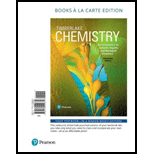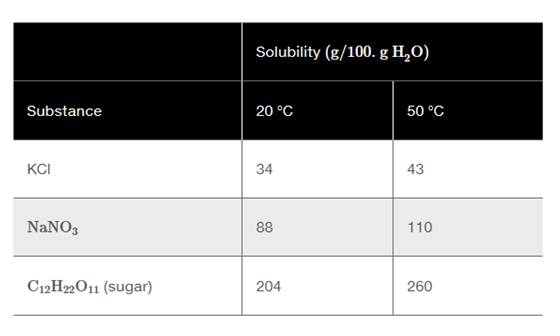
Chemistry: An Introduction to General, Organic, and Biological Chemistry, Books a la Carte Edition (13th Edition)
13th Edition
ISBN: 9780134554631
Author: Karen C. Timberlake
Publisher: PEARSON
expand_more
expand_more
format_list_bulleted
Concept explainers
Textbook Question
Chapter 9.3, Problem 9.24PP
State whether each of the following refers to a saturated or an unsaturated solution:
- A spoonful of salt added to boiling water dissolves.
- A layer of sugar forms on the bottom of a glass of tea and as ice is added.
- A kidney stone of calcium phosphate from in the Kidneys when urine become concentrated.
Use the following table for problems 9.25 to 9.28

Expert Solution & Answer
Want to see the full answer?
Check out a sample textbook solution
Students have asked these similar questions
The U. S. Environmental Protection Agency (EPA) sets
limits on healthful levels of air pollutants. The
maximum level that the EPA considers safe for lead air
pollution is 1.5 μg/m³
Part A
If your lungs were filled with air containing this level of lead, how many lead atoms would be in your lungs? (Assume a total lung
volume of 5.40 L.)
ΜΕ ΑΣΦ
= 2.35 1013
?
atoms
! Check your rounding. Your final answer should be rounded to 2 significant figures in the last step.
No credit lost. Try again.
Y= - 0.039 (14.01) + 0.7949
Suppose 1.76 g of magnesium acetate (Mg (CH3CO2)2) are dissolved in 140. mL of water. Find the composition of the resulting electrolyte solution.
In particular, list the chemical symbols (including any charge) of each dissolved ion in the table below. List only one ion per row.
mEq
Then, calculate the concentration of each ion in
dwrite the concentration in the second column of each row. Be sure you round your answers to the
L
correct number of significant digits.
ion
Add Row
mEq
L
x
5
Chapter 9 Solutions
Chemistry: An Introduction to General, Organic, and Biological Chemistry, Books a la Carte Edition (13th Edition)
Ch. 9.1 - Prob. 9.1PPCh. 9.1 - Prob. 9.2PPCh. 9.1 - Describe the formation of an aqueous KI solution,...Ch. 9.1 - Describe the formation of an aqueous LiBr...Ch. 9.1 - Prob. 9.5PPCh. 9.1 - Water is a polar solvent and hexane (C6H12)is a...Ch. 9.2 - Prob. 9.7PPCh. 9.2 - NaOHis a strong electrolyte, and CH3OH is a...Ch. 9.2 - Write a balanced equation for the dissociation of...Ch. 9.2 - Write the balanced equation for the dissociation...
Ch. 9.2 - Indicate whether aqueous solutions of each of the...Ch. 9.2 - Prob. 9.12PPCh. 9.2 - Prob. 9.13PPCh. 9.2 - Prob. 9.14PPCh. 9.2 - Calculate the number of equivalents in each of the...Ch. 9.2 - Calculate the number of equivalents in each of the...Ch. 9.2 - An intravenous saline solution contains 154 mEq/L...Ch. 9.2 - An intravenous solution to replace potassium loss...Ch. 9.2 - Prob. 9.19PPCh. 9.2 - A Ringer's solutioncontains the following...Ch. 9.2 - When Michael's blood was tested, the chloride...Ch. 9.2 - After dialysis, the level of magnesium in...Ch. 9.3 - State whether each of the following refers to a...Ch. 9.3 - State whether each of the following refers to a...Ch. 9.3 - Determine whether each of the following solutions...Ch. 9.3 - Determine whether each of the following solutions...Ch. 9.3 - A solution containing 80. g of KClin 200 g of H2O...Ch. 9.3 - A solution containing 80. g of NaNO3 in 75 g of...Ch. 9.3 - Explain the following observations More sugar...Ch. 9.3 - Explain the following observations: And open can...Ch. 9.3 - Predict whether each of the following organic...Ch. 9.3 - Predict whether each of the following organic...Ch. 9.4 - Calculate the mass percent (m/m) for the solute in...Ch. 9.4 - Calculate the mass percent (m/m) for the solute in...Ch. 9.4 - A mouthwash contains 22.5% (v/v) alcohol.If the...Ch. 9.4 - A bottle of champagne is 11% (v/v) alcohol. If...Ch. 9.4 - What is the difference between a 5.0% (m/m)...Ch. 9.4 - What is the difference between a 10.0% (v/v)...Ch. 9.4 - Calculate the mass/volume(m/v) percent for the...Ch. 9.4 - Calculate the mass/volume (m/v) percent for the...Ch. 9.4 - Calculate the grams or milliliters of solute...Ch. 9.4 - Calculate the grams or ml of solute needed to...Ch. 9.4 - Prob. 9.43PPCh. 9.4 - For each of the following solutions, calculate...Ch. 9.4 - Prob. 9.45PPCh. 9.4 - Prob. 9.46PPCh. 9.4 - Calculate the gram of solely needed to prepare...Ch. 9.4 - Calculate the gram of solute needed to prepare...Ch. 9.4 - For each of the following solutions, calculate...Ch. 9.4 - Prob. 9.50PPCh. 9.4 - A patient received 100 mL of a 20.0% (m/v)...Ch. 9.4 - A patient received 250 mL of a 4.0% (m/v) amino...Ch. 9.4 - A patient needs 100. g of glucose in the next 12...Ch. 9.4 - A patient received 2.0 g of NaCl in 8 h. How many...Ch. 9.5 - Prob. 9.55PPCh. 9.5 - Prob. 9.56PPCh. 9.5 - Determine the final volume, in milliliters, of...Ch. 9.5 - Prob. 9.58PPCh. 9.5 - Prob. 9.59PPCh. 9.5 - Prob. 9.60PPCh. 9.5 - You need 500. mL of a 5.0% (m/v) glucose solution....Ch. 9.5 - A doctor ordered 100. mL of 2.0% (m/v)...Ch. 9.6 - Prob. 9.63PPCh. 9.6 - Identify each of the following as characteristics...Ch. 9.6 - A 10% (m/v) starch solution is separated form a 1%...Ch. 9.6 - A 0.1% (m/v) albumin solution is separated form a...Ch. 9.6 - Indicate the compartment (A or B) that will...Ch. 9.6 - Indicate the compartment (A or B) that will...Ch. 9.6 - Will a red blood cell undergo creation, hemolysis,...Ch. 9.6 - Will a red blood cell undergo creation, hemolysis,...Ch. 9.6 - Each of the following mixtures is placed in a...Ch. 9.6 - Prob. 9.72PPCh. 9.6 - 9.73 After her latest dialysis treatment, Michael...Ch. 9.6 - Prob. 9.74PPCh. 9.6 - 9.75 A CaCl2solution is given to increase blood...Ch. 9.6 - 9.76 10 intravenous solution of mannitol is used...Ch. 9 - Prob. 9.77UTCCh. 9 - Prob. 9.78UTCCh. 9 - Prob. 9.79UTCCh. 9 - Prob. 9.80UTCCh. 9 - Prob. 9.81UTCCh. 9 - Whydo lettuces leaves in a salad with after a...Ch. 9 - Prob. 9.83UTCCh. 9 - Prob. 9.84UTCCh. 9 - Prob. 9.85APPCh. 9 - Prob. 9.86APPCh. 9 - Prob. 9.87APPCh. 9 - Prob. 9.88APPCh. 9 - Prob. 9.89APPCh. 9 - Prob. 9.90APPCh. 9 - Prob. 9.91APPCh. 9 - Prob. 9.92APPCh. 9 - Prob. 9.93APPCh. 9 - Prob. 9.94APPCh. 9 - Prob. 9.95APPCh. 9 - Prob. 9.96APPCh. 9 - Prob. 9.97APPCh. 9 - Prob. 9.98APPCh. 9 - Prob. 9.99APPCh. 9 - Prob. 9.100APPCh. 9 - Prob. 9.101APPCh. 9 - Prob. 9.102APPCh. 9 - Prob. 9.103APPCh. 9 - Prob. 9.104APPCh. 9 - Prob. 9.105APPCh. 9 - Prob. 9.106APPCh. 9 - Calculate the final concentration of the solution...Ch. 9 - Calculate the final concentration of the solution...Ch. 9 - Prob. 9.109APPCh. 9 - Prob. 9.110APPCh. 9 - Prob. 9.111APPCh. 9 - Prob. 9.112APPCh. 9 - Prob. 9.113CPCh. 9 - 9.114. In a laboratory experiment, a 15.0-sample...Ch. 9 - Prob. 9.115CPCh. 9 - Prob. 9.116CPCh. 9 - Prob. 9.117CPCh. 9 - Prob. 9.118CPCh. 9 - Prob. 13CICh. 9 - Automobile exhaust is a major cause of air...Ch. 9 - Bleach is often added to a wash to remove stains...Ch. 9 - The compound butyric acid gives rancid butter its...Ch. 9 - Methane is a major component of purified natural...Ch. 9 - The active ingredient in Turns is calcium...Ch. 9 - Tamiflu (oseltamivir), C16H28N2O4, is an antiviral...Ch. 9 - Prob. 20CI
Knowledge Booster
Learn more about
Need a deep-dive on the concept behind this application? Look no further. Learn more about this topic, chemistry and related others by exploring similar questions and additional content below.Similar questions
- A pdf file of your hand drawn, stepwise mechanisms for the reactions. For each reaction in the assignment, you must write each mechanism three times (there are 10 reactions, so 30 mechanisms). (A) do the work on a tablet and save as a pdf., it is expected to write each mechanism out and NOT copy and paste the mechanism after writing it just once. Everything should be drawn out stepwise and every bond that is formed and broken in the process of the reaction, and is expected to see all relevant lone pair electrons and curved arrows.arrow_forwardNonearrow_forwardNonearrow_forward
- Draw the structure of the product of the reaction given the IR and MS data. Spectral analysis of the product reveals: MS: M 150, M-15, M-43 CH.COCI AICI, IR: 3150-3000 cm, 2950-2850 cm and 1700 cmarrow_forwardPart II. Identify whether the two protons in blue are homotopic, enantiopic, diasteriotopic, or heterotopic. a) HO b) Bri H HH c) d) H H H Br 0arrow_forwardNonearrow_forward
- Choose the option that is decreasing from biggest to smallest. Group of answer choices: 100 m, 10000 mm, 100 cm, 100000 um, 10000000 nm 10000000 nm, 100000 um, 100 cm, 10000 mm, 100 m 10000000 nm, 100000 um, 10000 mm, 100 cm, 100 m 100 m, 100 cm, 10000 mm, 100000 um, 10000000 nmarrow_forwardQ1. (a) Draw equations for homolytic and heterolytic cleavages of the N-H bond in NH3. Use curved arrows to show the electron movement. (b) Draw equations for homolytic and heterolytic cleavages of the N-H bond in NH4*. Use curved arrows to show the electron movement.arrow_forwardWhich is NOT the typical size of a bacteria? 1000 nm 0.001 mm 0.01 mm 1 umarrow_forward
arrow_back_ios
SEE MORE QUESTIONS
arrow_forward_ios
Recommended textbooks for you
 World of Chemistry, 3rd editionChemistryISBN:9781133109655Author:Steven S. Zumdahl, Susan L. Zumdahl, Donald J. DeCostePublisher:Brooks / Cole / Cengage Learning
World of Chemistry, 3rd editionChemistryISBN:9781133109655Author:Steven S. Zumdahl, Susan L. Zumdahl, Donald J. DeCostePublisher:Brooks / Cole / Cengage Learning Chemistry & Chemical ReactivityChemistryISBN:9781337399074Author:John C. Kotz, Paul M. Treichel, John Townsend, David TreichelPublisher:Cengage Learning
Chemistry & Chemical ReactivityChemistryISBN:9781337399074Author:John C. Kotz, Paul M. Treichel, John Townsend, David TreichelPublisher:Cengage Learning Chemistry & Chemical ReactivityChemistryISBN:9781133949640Author:John C. Kotz, Paul M. Treichel, John Townsend, David TreichelPublisher:Cengage Learning
Chemistry & Chemical ReactivityChemistryISBN:9781133949640Author:John C. Kotz, Paul M. Treichel, John Townsend, David TreichelPublisher:Cengage Learning- Chemistry: Matter and ChangeChemistryISBN:9780078746376Author:Dinah Zike, Laurel Dingrando, Nicholas Hainen, Cheryl WistromPublisher:Glencoe/McGraw-Hill School Pub Co
 EBK A SMALL SCALE APPROACH TO ORGANIC LChemistryISBN:9781305446021Author:LampmanPublisher:CENGAGE LEARNING - CONSIGNMENT
EBK A SMALL SCALE APPROACH TO ORGANIC LChemistryISBN:9781305446021Author:LampmanPublisher:CENGAGE LEARNING - CONSIGNMENT General, Organic, and Biological ChemistryChemistryISBN:9781285853918Author:H. Stephen StokerPublisher:Cengage Learning
General, Organic, and Biological ChemistryChemistryISBN:9781285853918Author:H. Stephen StokerPublisher:Cengage Learning

World of Chemistry, 3rd edition
Chemistry
ISBN:9781133109655
Author:Steven S. Zumdahl, Susan L. Zumdahl, Donald J. DeCoste
Publisher:Brooks / Cole / Cengage Learning

Chemistry & Chemical Reactivity
Chemistry
ISBN:9781337399074
Author:John C. Kotz, Paul M. Treichel, John Townsend, David Treichel
Publisher:Cengage Learning

Chemistry & Chemical Reactivity
Chemistry
ISBN:9781133949640
Author:John C. Kotz, Paul M. Treichel, John Townsend, David Treichel
Publisher:Cengage Learning

Chemistry: Matter and Change
Chemistry
ISBN:9780078746376
Author:Dinah Zike, Laurel Dingrando, Nicholas Hainen, Cheryl Wistrom
Publisher:Glencoe/McGraw-Hill School Pub Co

EBK A SMALL SCALE APPROACH TO ORGANIC L
Chemistry
ISBN:9781305446021
Author:Lampman
Publisher:CENGAGE LEARNING - CONSIGNMENT

General, Organic, and Biological Chemistry
Chemistry
ISBN:9781285853918
Author:H. Stephen Stoker
Publisher:Cengage Learning
Solutions: Crash Course Chemistry #27; Author: Crash Course;https://www.youtube.com/watch?v=9h2f1Bjr0p4;License: Standard YouTube License, CC-BY